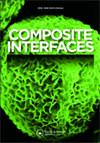Direct ink writing of high-performance multi-level interlocked laminate-network titanium matrix composites
IF 2.4
4区 材料科学
Q3 MATERIALS SCIENCE, COMPOSITES
引用次数: 0
Abstract
ABSTRACTIn this study, multi-level laminate-network boron nitride nanosheets (BNNSs)/TC4 composite with interlayer interlocking was fabricated using a facile direct ink writing (DIW) technique. In-situ 3D nano-configurations consisting of BNNSs and TiBx nanophases distributed around TC4 matrix particles formed the first-level network structure, while the above composite layers and TC4 layers with interlayer interlocking formed the second-level laminate structure. It exhibits a comparable high tensile strength of around 1203 MPa, compared to composites with a single-network structure, while demonstrating a 20% higher toughness of 55.8 MJ/m3. The interlayer interlocking microstructure interlayer could be responsible for the strength enhancement, which benefits the stress transfer between layers. The improved ductility could be attributed to the crack blocking adduced by the laminate structure and the 3D network in the composite layers.KEYWORDS: Metal matrix compositesdirect ink writingmulti-level microstructuremechanical propertiesstrengthening mechanisms Disclosure statementNo potential conflict of interest was reported by the author(s).Supplementary dataSupplemental data for this article can be accessed online at https://doi.org/10.1080/09276440.2023.2264039Additional informationFundingThis work was supported by the Postgraduate Research & Practice Innovation Program of Jiangsu Province under [Grant number KYCX21_3328]; The Research Foundation for the National Natural Science Foundation of China under [Grant number 51575245]; The National Science Foundation of Jiangsu Province under [Grant number BK20220533]; The Open Fund of Key Laboratory of Marine Materials and Related Technologies, CAS and Zhejiang Key Laboratory of Marine Materials and Protective Technologies under [Grant number 2020K06]; The senior Talent Foundation of Jiangsu University under [Grant number 18JDG030].高性能多级联锁层状网络钛基复合材料的直接墨水书写
摘要本研究采用直接墨水书写(DIW)技术制备了多层层状网络氮化硼纳米片(BNNSs)/TC4复合材料。由分布在TC4基体颗粒周围的BNNSs和TiBx纳米相组成的原位三维纳米构型形成了第一级网状结构,而上述复合层与层间互锁的TC4层形成了第二级层状结构。与单网络结构的复合材料相比,它具有1203 MPa左右的高抗拉强度,同时显示出高达20%的55.8 MJ/m3的韧性。层间的互锁微观结构可以增强材料的强度,有利于层间的应力传递。复合材料延性的提高可归因于层状结构引起的裂纹阻塞和复合材料层内的三维网络。关键词:金属基复合材料;直接油墨书写;多层次显微组织;补充数据本文补充数据可在线获取:https://doi.org/10.1080/09276440.2023.2264039Additional information基金资助:江苏省研究生科研与实践创新计划[批准号:KYCX21_3328];国家自然科学基金研究基金项目[批准号51575245];江苏省国家科学基金项目[批准号:BK20220533];中国科学院海洋材料与相关技术重点实验室、浙江省海洋材料与防护技术重点实验室开放基金[批准号2020K06];江苏大学高级人才基金[批准号:18JDG030]。
本文章由计算机程序翻译,如有差异,请以英文原文为准。
求助全文
约1分钟内获得全文
求助全文
来源期刊

Composite Interfaces
工程技术-材料科学:复合
CiteScore
5.00
自引率
3.80%
发文量
58
审稿时长
3 months
期刊介绍:
Composite Interfaces publishes interdisciplinary scientific and engineering research articles on composite interfaces/interphases and their related phenomena. Presenting new concepts for the fundamental understanding of composite interface study, the journal balances interest in chemistry, physical properties, mechanical properties, molecular structures, characterization techniques and theories.
Composite Interfaces covers a wide range of topics including - but not restricted to:
-surface treatment of reinforcing fibers and fillers-
effect of interface structure on mechanical properties, physical properties, curing and rheology-
coupling agents-
synthesis of matrices designed to promote adhesion-
molecular and atomic characterization of interfaces-
interfacial morphology-
dynamic mechanical study of interphases-
interfacial compatibilization-
adsorption-
tribology-
composites with organic, inorganic and metallic materials-
composites applied to aerospace, automotive, appliances, electronics, construction, marine, optical and biomedical fields
 求助内容:
求助内容: 应助结果提醒方式:
应助结果提醒方式:


